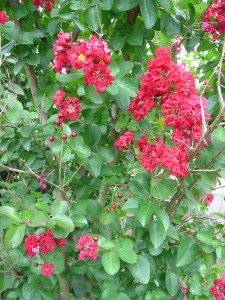There are several probable reasons why your crape myrtle did not flower this summer. The two leading reasons are lack of adequate daily sunlight and planting depth. Crape myrtles should be planted in full sun. They don’t flower well in locations receiving less than 6 hours of direct sunlight each day.
If the leaves are being heavily attacked by aphids or fungal diseases like Cercospora leaf spot and powdery mildew, the plant is not producing enough carbohydrates (food) to initiate flower buds. Also, the aphids feeding may be inflicting damage to the flower buds.
“Crape Murder” pruning after new spring growth has started can delay or completely eliminate flowering. Overpruning often promotes excessive growth at the expense of flowering. In fact, crape myrtles require little annual pruning. In most years pruning on crape myrtles should be mostly cosmetic, such as to cut off a dead or crossing branch or to remove last year’s old seed heads.
Poorly drained (too wet) soils is another cause. Unusually heavy amounts of rain may retard or completely eliminate flowering. Crape myrtles must be planted on a well-drained site. Heavy rainfalls also leach nutrients out of the ground.
Over-applying nitrogen-based fertilizers may push your crape myrtle into vegetative growth and few, if any, flowers may develop.
Crape myrtles do not tolerate deep planting. The upper-most (surface) roots should be at ground-level or an inch or two above, never several inches below the soil line. When planted too deep, the roots don’t get enough oxygen, leading to reduced growth and flowering.
Crapemyrtles can recover from deep planting over several years. They must regenerate a new root system closer to the surface. Removing mulch piled up around the base of the plant will help roots breathe.
Special Thanks to: Dr. Gary Knox at North Florida Research Center


 Posted in
Posted in 
